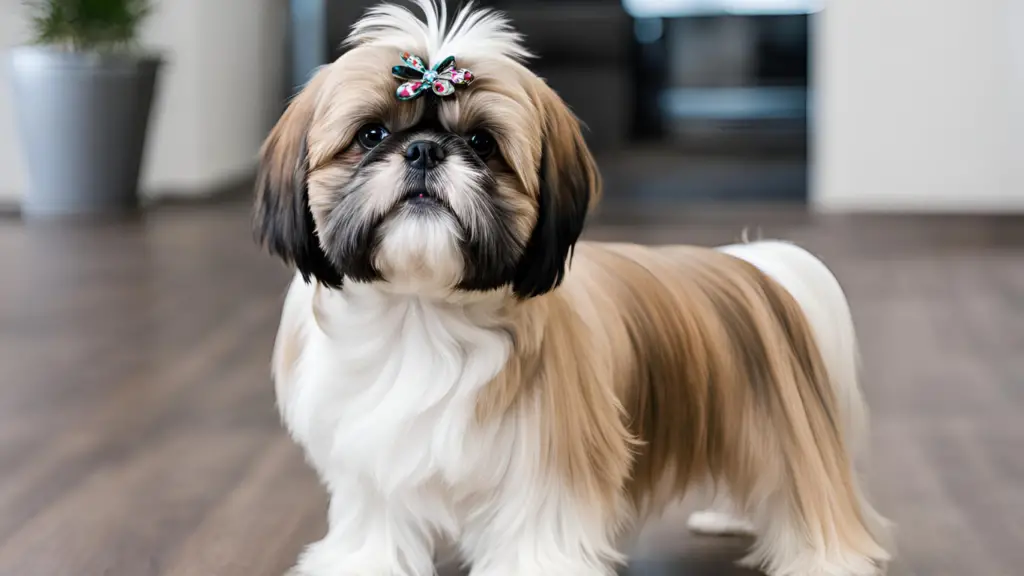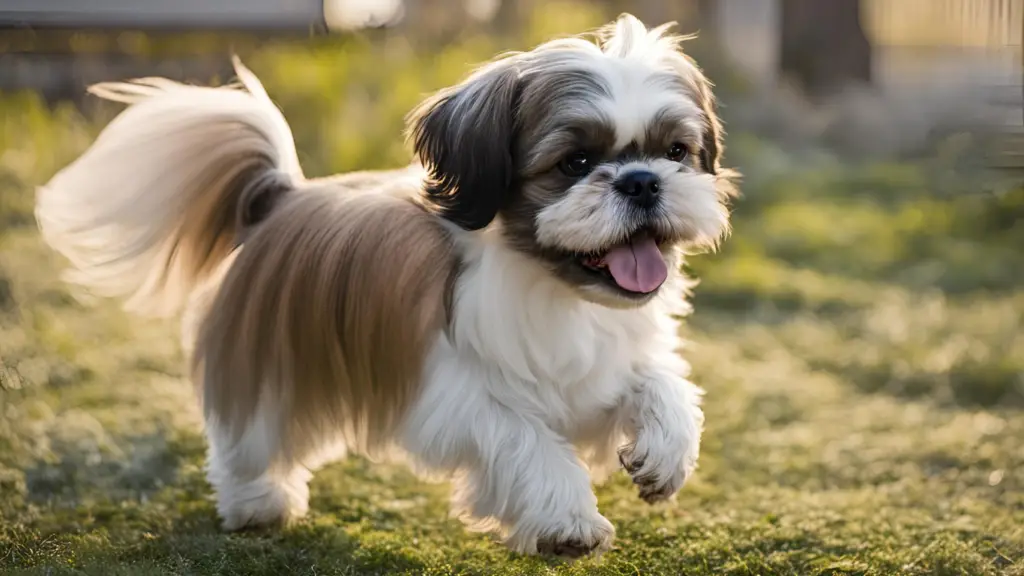
Shih Tzus are renowned for their luxurious and diverse coat colors and patterns. Their coats not only add to their charm but also reveal interesting insights about their genetic background and overall health. Understanding these colors and patterns can help you appreciate your Shih Tzu’s unique appearance and make informed decisions about their care. In this comprehensive guide, we’ll explore the different Shih Tzu coat colors and patterns, what they mean, and how they influence your dog’s personality and health.
Understanding Shih Tzu Coat Colors

Shih Tzus come in a variety of coat colors, each with its own distinct characteristics. These colors are determined by the genes inherited from both parents. Some colors are more common than others, and each brings a unique beauty to these adorable dogs.
Solid Colors
Solid colors in Shih Tzus are characterized by a single hue covering their entire coat. Common solid colors include white, black, brown, and golden. Each solid color has its own set of genetic factors.
White Shih Tzus often have a strikingly pure appearance. They may have slight variations in shade, such as cream or ivory, but are generally consistent in their whiteness. Black Shih Tzus are less common but equally stunning, with their dark coat providing a striking contrast against their facial features. Brown Shih Tzus, also known as liver-colored, exhibit a rich, warm hue that can range from deep chocolate to lighter tan. Golden Shih Tzus have a beautiful, sunny appearance, with shades ranging from pale cream to a deeper golden hue.

Color Dilution
Color dilution affects the intensity of the coat color. Diluted colors appear lighter than their standard counterparts. For instance, a diluted black Shih Tzu might have a greyish coat rather than a deep black one. Diluted brown, often referred to as champagne, has a lighter, softer appearance compared to the standard brown.
This dilution occurs due to specific genes that alter the pigmentation of the coat. Diluted coats can be particularly striking, giving the Shih Tzu a unique and elegant appearance.
Multi-Colored Coats

Shih Tzus with multi-colored coats feature more than one color in their fur. These coats can include bi-color, tri-color, and brindle patterns.
Bi-color Shih Tzus typically have two distinct colors, such as black and white, brown and white, or gold and white. These combinations often result in a classic, sophisticated look. Tri-color Shih Tzus have three colors, usually including white combined with two other colors like black and tan or brown and white. Brindle patterns involve stripes of different colors, often giving the coat a marbled or striped appearance.
Unique Color Patterns
Some Shih Tzus have unique patterns that add to their charm. Parti-color Shih Tzus have large patches of different colors, typically with a significant amount of white. Mask patterns involve a distinct color around the eyes and nose, giving the Shih Tzu a characteristic look.

Husky markings or saddle patterns are also seen, where a darker color covers the back and a lighter color covers the sides and legs. These patterns can vary widely and make each Shih Tzu uniquely beautiful.
Genetic Factors Behind Coat Colors
The diverse coat colors and patterns of Shih Tzus are a result of complex genetic combinations. Understanding these genetics can provide insights into your Shih Tzu’s lineage and potential health considerations.
The Role of Genetics

Genetics play a crucial role in determining a Shih Tzu’s coat color. Each parent contributes genes that influence the color and pattern of their puppies. These genes interact in various ways, leading to the wide array of coat colors and patterns seen in Shih Tzus.
For instance, the B locus gene determines whether a Shih Tzu will have a black or brown coat. The D locus gene affects color dilution, resulting in lighter shades of the base colors. The A locus gene influences the pattern and distribution of colors, leading to multi-colored and patterned coats.
Inheritance Patterns

Shih Tzu coat colors are inherited according to Mendelian genetics. This means that puppies receive one color gene from each parent, and the combination of these genes determines the puppy’s coat color. Dominant and recessive genes interact in complex ways to produce the final coat color.
For example, the solid black color is often dominant over brown, while dilution of colors can occur when specific genes are present. Understanding these inheritance patterns can help predict the potential coat colors of future litters.
Health Implications of Coat Colors

Certain coat colors and patterns can be associated with specific health issues. For example, white Shih Tzus can be prone to deafness and vision problems due to a genetic condition known as waardenburg syndrome. It’s essential to be aware of these potential health concerns and consult with a veterinarian for regular check-ups.
Color dilution can sometimes be associated with skin sensitivity and allergies. Regular grooming and proper skin care can help manage these issues. Ensuring that your Shih Tzu’s coat is clean and well-maintained can mitigate potential health problems related to their coat color.
Grooming Tips for Different Coat Colors
Proper grooming is essential to maintain the health and appearance of your Shih Tzu’s coat, regardless of its color or pattern. Different coat colors and patterns may require specific grooming techniques to keep your Shih Tzu looking and feeling its best.

Brushing Techniques
Regular brushing is crucial for all Shih Tzus, but the technique can vary based on coat color and pattern. For solid-colored Shih Tzus, brushing helps remove loose fur and prevents mats. For multi-colored or patterned coats, brushing can help distribute natural oils evenly and prevent tangling in areas with different colors.
Use a high-quality slicker brush or comb to remove tangles and mats, and consider a detangling spray for easier grooming. Regular brushing also helps keep your Shih Tzu’s coat shiny and healthy, regardless of its color.

Bathing and Shampoos
Bathing your Shih Tzu regularly is essential for maintaining a clean and healthy coat. Choose a gentle dog shampoo suited to your Shih Tzu’s coat type and color. For example, color-enhancing shampoos can be used to brighten the coat of a white or cream Shih Tzu, while sensitive skin shampoos are ideal for those with color dilution or skin sensitivities.
Always rinse thoroughly to avoid residue that can cause irritation. Follow up with a conditioner to keep the coat soft and manageable. Regular bathing helps maintain the vibrancy of your Shih Tzu’s coat and prevents buildup of dirt and oil.
Managing Specific Coat Issues

Different coat colors and patterns may present unique grooming challenges. For example, white Shih Tzus may develop tear staining, which can be managed with tear stain remover products and regular cleaning. Brindle patterns may require extra attention to ensure that stripes remain distinct and free from mats.
For color-diluted coats, ensure that your Shih Tzu’s skin is well-hydrated and protected from the sun. Use pet-safe sunscreen if your dog will be exposed to prolonged sunlight, as diluted coats can be more susceptible to sunburn.

Understanding Your Shih Tzu’s Coat and Personality
Your Shih Tzu’s coat color and pattern can also provide insights into their personality and behavior. While personality traits are influenced by a variety of factors, including genetics and environment, certain coat colors and patterns may be associated with specific characteristics.
Personality Traits and Coat Color

While there is no definitive link between coat color and personality, some owners believe that certain colors can be indicative of temperament. For example, golden Shih Tzus are often thought to be friendly and outgoing, while black Shih Tzus may be perceived as more reserved. However, it’s important to remember that each dog is an individual, and personality is shaped by a combination of factors.
Behavioral Traits and Patterns
Shih Tzus with unique patterns such as brindle or parti-color may attract more attention, which can influence their behavior. These dogs may become accustomed to being the center of attention and develop a more outgoing or attention-seeking personality. Similarly, bi-color and tri-color Shih Tzus may have distinctive looks that make them stand out in social settings.
Bonding and Care

Regardless of coat color or pattern, all Shih Tzus require love, care, and attention. Building a strong bond with your Shih Tzu involves regular grooming, training, and socialization. Understanding your dog’s unique needs and personality will help ensure a happy and fulfilling relationship.
Conclusion
Shih Tzus are a breed with remarkable diversity in coat colors and patterns, each adding to their unique beauty and charm. From solid colors and multi-colored coats to distinctive patterns and color dilution, every Shih Tzu’s coat tells a story of genetics and individual characteristics. Understanding these aspects not only enhances your appreciation of your Shih Tzu’s appearance but also helps in providing the best care and grooming practices.
By recognizing the significance of coat colors and patterns, you can better care for your Shih Tzu’s health and well-being. Whether you have a solid black, golden brindle, or parti-color Shih Tzu, proper grooming and attention to their unique needs will ensure they remain happy and healthy. Remember, every Shih Tzu is a special reflection of their lineage, and their coat is a beautiful testament to their individuality.


